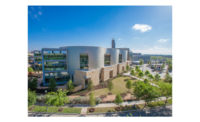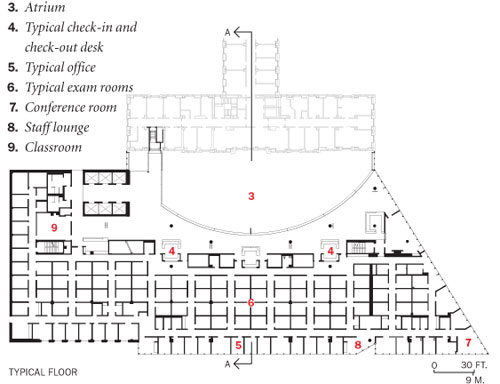New York City
An estimated 10,000 people walk through the entrance to New York City’s Bellevue Hospital every day, many of them surely unaware as they traverse Pei Cobb Freed & Partners’ new glass atrium that the hospital is one of the oldest in the Western Hemisphere.
Bellevue has been caring for the city’s people since 1736. Originally built as an almshouse at the Lower Manhattan site of City Hall, the hospital moved in 1794 to what was formerly an 18th-century farm, called “Belle Vue,” along the East River between 25th and 30th Streets. The site today is a confusing complex of hospital buildings representing various design approaches, squeezed in the midst of a typically dense Manhattan neighborhood.
In 2000, the hospital charged Pei Cobb Freed with the design of a new 210,000-square-foot ambulatory-care pavilion and main entrance for First Avenue. The five-story pavilion houses 270 exam rooms for noncritical hospital functions, such as dermatology, adult and child primary care, and a women’s center, as well as an outpatient cancer center on an additional mezzanine floor tucked into the north side of the ground floor.
Initial plans called for placing the new building on the site of an adjacent garden, south of where the new building stands. Ian Bader, AIA, of Pei Cobb Freed, says that given Manhattan’s lack of green space throughout the city, the design team felt it was important to preserve the garden and to open the ground floor to the public as much as possible.The new building’s ground-level transparency is achieved with 12-foot-high sheets of glass set in a channel and anchored to the ceiling all along the front entryway. A ramp takes visitors down the 5-foot elevation change from the street to the Connecticut granite floor of the hospital’s new atrium lobby.
Each patient floor combines a distinct color scheme with a mural developed by the architects using photographs from the hospital’s rich historical archive. Color schemes for exam rooms vary and corridors terminate in daylight views, ensuring that patients encounter distinct environments on each visit.
The building acts as a beacon at night, with the ceiling plane pulled away from the slab edge along the exterior curtain wall to indicate the full 12-foot, floor-to-floor height so perimeter indirect T5 fluorescent lighting can illuminate the curtain wall. At night, lights installed in windows in the existing building reflect off mirrors hung from the atrium structure to wash the entire brick facade.
|
People Owner Architect Ian Bader, AIA, George H. Miller, FAIA, Michael D. Flynn, FAIA, Richard Cutter, AIA, Associate Partner, Bea Lehman, AIA, Kyle Johnson, AIA, Andre Morawski, RA, ASLA, Robin Taff, AIA, Thomas Woo, AIA, Deborah Young, AIA, Que Ranne Rhee, Elizabeth Polenz, AIA, Kerry Sheehan, AIA, Howard Settles, RA, Karen Goor, Apisit Thanavuthiporn, Blandine Seguin, Florent Nedelec & Masa Ogasawara, Engineer(s) Structural: Geotechnical Engineering: Consultant(s) Lighting: Acoustical: Hospital Planning and Programming: Equipment Planning: General contractor Principal Prime Contractors General Construction: Structural Steel: Superstructure Concrete: Curtain Wall: Skylight: Masonry: Elevators: Signage: Security: Granite floors: Mechanical: Electrical: Plumbing: Fire Protection: BMS: Photographer(s) Jeff Goldberg Renderer(s) CAD system, project management, or other software used
|
Products Structural system Exterior cladding Metal/glass curtainwall: Concrete: Wood: Roofing Windows Skylight: Glazing Skylight: Doors Metal doors: Wood doors: Sliding doors: Fire-control doors, security grilles: Hardware Hinges: Closers: Exit devices: Pulls: Security devices: Hinges: Drawer Pulls: Standard: Door Slide: Magnetic Catch: Lock: Interior finishes Suspension grid: Sonata system dimensional Tee Cabinetwork and custom woodwork: Constructamax Sub-contractor: Paints and stains: Murals: Paneling: Plastic laminate: Floor and wall tile: Granite Paving: VCT flooring: Sheet Vinyl: Carpet: Cubicle curtains: Window Treatment: Furnishings Desks: Reception desks: Waiting area seating: Fixed seating: Chairs: Tables: Exam Room Workstations: Monitor arms, CPU holders, and keyboard trays: Children’s furniture: Lighting Atrium Mirror system: Downlights: Task lighting: Exterior: Controls: Conveyance Plumbing Drinking fountains: Major Medical Equipment Dental Equipment: Vital Signs Monitoring: Diagnostic Sets: ENT Treatment Cabinets: Defibrillators: Electrocautery Units: Physical Therapy Equipment: Phototherapy Cabinets: Ophthalmic Equipment: Refrigerators: Scales: |
|






















